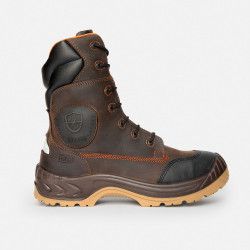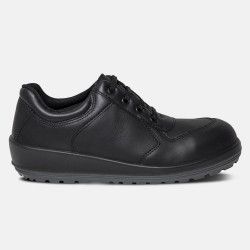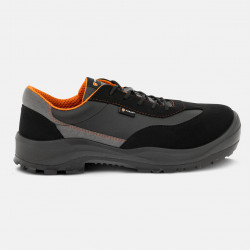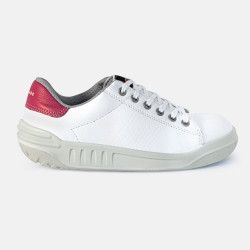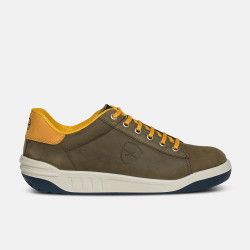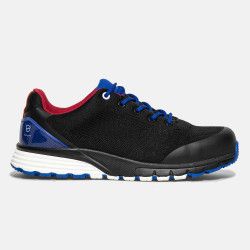Practical advice & expertise
ALL YOU NEED TO KNOW ABOUT SAFETY SHOE MATERIALS
The choice of materials used in safety shoes is important. The materials used to construct safety shoes must comply with the requirements of the working environment and the needs of the wearer (comfort, breathability, etc.).
In this article, we'll start by looking at the materials that make the uppers of safety shoes, their advantages and disadvantages. Then we'll look at the materials used in the soles of Parade Protection safety and work shoes.

1. What is a shoe upper?
The part of the shoe that covers the foot is called the "upper". The upper can be made from a variety of materials, including leather (full-grain, split, nubuck, etc.), microfibre, fabric and many others. The choice of upper components depends on the shoe's use. For example, resistance to liquids, breathability, resistance to hydrocarbons and ease of cleaning. But it also depends on the additional standards and requirements to which the shoe must comply.
2. Upper materials
THE DIFFERENT LEATHERS
Leather is a natural material made from animal skin. It is made up of two layers: the "grain" (outer layer) on the hair side and the "hide" (lower layer), which is the part on the flesh side.
- Full-grain leather : Full-grain leather corresponds the exposed hair side. The grain is the first outer layer of the animal's skin where the hair grows. This is a leather where the grain has not been sanded and which has a high-quality appearance. This is the skin's strongest layer; by its very nature it protects against external aggression.
- Split leather : Split leather is the thickness of leather obtained when the animal skin is split to obtain the desired thickness. Splitting is the process of dividing leather into several layers to obtain the grain (hair side) and the hide (flesh side). Split leather is therefore the bottom (inner) layer of the material.
- Nubuck leather : This is a leather that has undergone a light sanding of the original surface (the grain). It feels like peach skin and has a velvety feel.
- Oiled leather / pull-up leather : This leather has been immersed in oil. This oil is nourishing, waterproofing and protective.
Advantages of leather
Le cuir est un matériau confortable, solide, isolant et respirant.
Leather is comfortable, strong, insulating and breathable.
Leather is renowned for its durability and strength. It has a natural resistance to liquids. At Parade Protection, a large proportion of our S3 safety shoes are made of leather, as this standard requires a water-repellent upper material, i.e. one that slows down the penetration of water into the shoe.
What's more, it's a material with real breathability and absorbency properties. Leather is a natural material that allows vapour to pass through, which is a great advantage when it comes to perspiration. It is therefore a very good temperature regulator. As for the material's absorption capacity, leather can absorb 3 times its own weight.
For those of you with foot perspiration problems, we recommend leather safety shoes. These will facilitate air exchange between the outside and inside.
Disadvantages of leather
As we mentioned earlier, leather is a natural material that is sensitive to damage and can tend to age, dry out or stain. For these reasons, as well as for reasons of aesthetics, flexibility and solidity, leather needs to be cared for.
To find out more about maintaining your leather footwear, take a look at our article on how to clean your safety shoes, click here.
Selection of Parade leather safety shoes:

MICROFIBRE
Microfibre is an imitation leather made from synthetic fibres.
Just like genuine leather, it is very soft to the touch. The surface can be embossed with different types of grain and colour.
Advantages of microfibre:
-Microfibre is a soft material, so it makes safety shoes comfortable.
-What's more, like leather, microfibre has a natural resistance to liquids.
-Microfibre is very easy to clean, so you can wash your shoes in soapy water.
Disadvantages of microfibre:
Microfibre can discolour if it is of poor quality and exposed to sunlight.
Leather and/or microfibre safety shoes are better suited to an outdoor working environment where the wearer may be subject to liquid splashes. In addition, S2 and S3 safety shoes have the "WRU" requirement, i.e. the upper material must be made of a water-repellent material (which slows down the penetration of water into the shoe).
Selection of Parade Protection microfibre safety shoes:
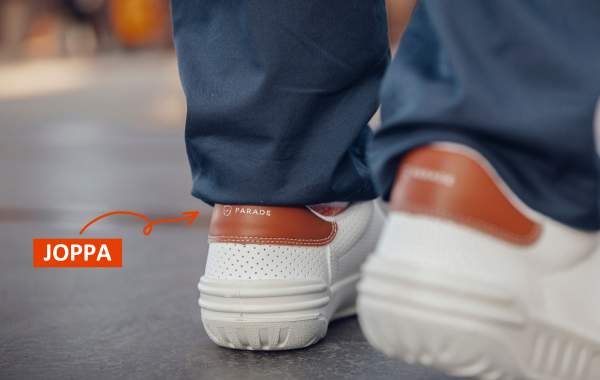
FABRICS
Fabrics are made from natural or synthetic fibres. "Fabric" is the term used to define the family of yarn-based materials.
Advantages of fabrics:
-A fabric is a breathable material that's ideal for summer.
-In terms of aesthetics, fabrics can be used to create a wide range of designs for the upper of a safety shoe.
-Fabric shoes generally cost less.
Disadvantages of fabrics:
-Fabrics are not impermeable to liquids
-They can stain more easily
-As fabrics have a woven surface, it is easier for damage to occur
-Because of these fibres, fabrics may tend to change shape. What's more, the colour of fabric shoes can also tend to fade when exposed to the elements, like sunshine.
Fabrics need to be waterproofed to make them more water-repellent. Waterproofing your fabric shoes will protect them from dirt and from ageing too quickly.
Fabric footwear cannot be put in the washing machine. Use a damp cloth to clean them instead.
Selection of Parade Protection fabric safety shoes:

EVA
EVA stands for “ethylene-vinyl acetate”. Its properties make it a "rubbery" material; it is flexible and supple. It is a featherweight material, so the safety shoe is lightweight.
Advantages of EVA:
-It is soft and supple, making it comfortable to wear
-It is hard-wearing and genuinely robust
-EVA can absorb very high impact when you walk or jump.
-EVA is waterproof
Disadvantages of EVA:
-EVA is a material that does not allow air to exchange between the inside of the shoe and the outside, which can lead to an increase in humidity inside the shoe and odours.
At Parade, we've created openings in our EVA safety shoes to let your feet breathe!
Parade Protection EVA work shoe:
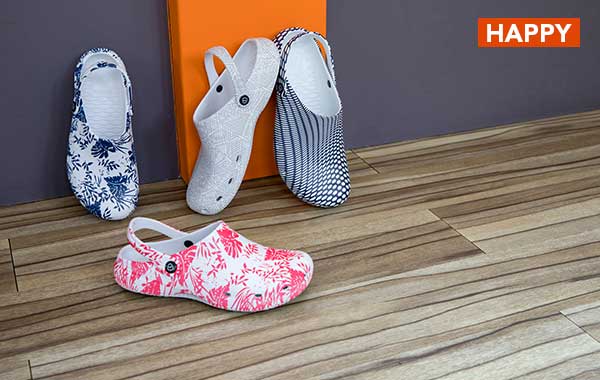
At Parade, we use a combination of materials for our safety shoes, matching the qualities of one material with those of another.
If your feet sweat, don't forget to think about what material your socks are made of too! Choose socks that allow more heat exchange. The ultra-breathable TOKYO and MIAMI socks will be perfect for you.
And don't forget to change them every day! ;)
3. Outsole materials
The sole of safety shoes guarantees cushioning comfort and stability. The sole and upper can be assembled using a variety of methods. At Parade, the soles of our safety shoes are injected directly onto the upper. The soles of the safety and work shoes we manufacture can be made from these 3 materials: polyurethane, EVA (ethylene vinyl acetate) or rubber.
Rubber :
Rubber is a material that can be obtained from the secretion of certain plants, but also synthetically.
It is an abrasion-resistant material with adhesive properties. What's more, it can withstand heat of 300°C.
Safety shoes with rubber soles are particularly suitable for jobs in the metal industry or for jobs that involve a lot of walking, as rubber tends to wear less than other materials.
Polyurethane (PU) :
Polyurethane is a plastic. It is an abrasion-resistant material that makes long-lasting soles. This resistance is well known, but it still lags behind rubber. This robust material makes soles ideal for outdoor jobs such as gardening and construction. PU also has excellent shock-absorption and non-slip properties. Finally, another advantage of PU is linked to the safety shoe manufacturing process: the PU sole is injected directly onto the upper, making the two parts virtually inseparable.
EVA :
EVA (ethylene vinyl acetate) is also a plastic.
It is a soft material that gives the sole real flexibility. What's more, EVA is featherweight, so the safety shoe is really light. Finally, EVA can absorb very high impact when you walk or jump.
EVA shoes are better suited to the healthcare sector because they are machine washable and can therefore be disinfected.
Taking onboard the materials used in the upper and/or sole of Parade safety shoes will help you to find the product that is right for you in every respect, in line with the requirements of your work environment and your more specific needs (comfort, breathability, flexibility, etc.).
Related products
DISCOVER OUR NEWSLETTER
By entering your email address, you will receive our newsletter with our latest products, services, news and advice on prevention and safety.

